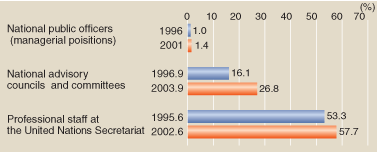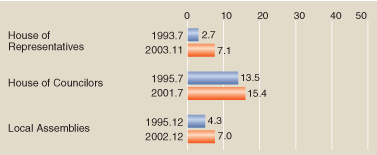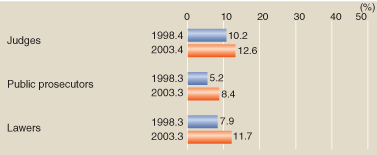![]()
Basic Data on Gender Equality in Japan
- Women's Participation in Various Fields
-
Administration
The percentage of female national public officers in high-ranked managerial positions stood at 1.4% as of FY2001 and has shown a gradual increase over the long term.
According to the survey as of September 30, 2003, the proportion of female members of national advisory councils and committees has risen substantially to 26.8%. Moreover, 98.0% of advisory councils and committees had female members; and 40 of them, 39.2% of the total number, had no less than 30% female representation.
-
International Fields
Eleven women have been appointed ambassador extraordinary or plenipotentiary since the Japanese government appointed its first female ambassador in 1980. Four of them currently serve as ambassadors to Italy, Ghana, Norway and the Disarmament Mission, and women account for approximately 3.3% of all Japanese ambassadorships (as of December 15, 2003).
At the end of June 2002, women accounted for 57.7% of all Japanese staff in the Secretariat of the United Nations.
The number of Japanese female staff at major international organizations including the United Nations has increased from 180 in 1994 to 362 in 2003. As of January 2004, Japanese women in senior positions include the Deputy Executive Secretary of ESCAP, the Deputy Director General of UNIDO, and the Executive Secretary of the Secretariat of the Basel Convention.
WOMEN'S PARTICIPATION IN ADMINISTRATION AND INTERNATIONAL FIELDS

(Sources)
National public officers, National Personnel Authority; National advisory councils and committees, Cabinet Office; Professional staff at the United Nations Secretariat, Recruitment Center for International Organizations -
Politics
Except for a short period after the Second World War, the percentage of female members of the House of Representatives had wavered between 1% and 2% until the thirty-eighth general elections in 1986, and, since then, this percentage has started to rise reaching 7.1% as of November 2003. Female membership of the House of Councillor has risen gradually from 4% in the first ordinary elections in 1947 to 15.4% as of July 2001. Female representation in local assemblies is comparatively high, standing at 20.2% (as of the end of December 2002) in special ward assemblies (Tokyo), and 14.9% (as of the end of December 2002) in government-designated cities.
WOMEN'S PARTICIPATION IN POLITICS

(Sources)
House of Representatives, house of Councilors and local assemblies, Ministry of Public Management, Home Affairs, Posts and Telecommunications -
Judiciary
The percentage of female judges, public prosecutors, and lawyers has been increasing over the long run.
WOMEN'S PARTICIPATION IN THE JUDICIARY

(Sources)
Judges, Supreme Court; Public prosecutors, Ministry of Justice; Lawyers, Secretariat of the Japan Federation of Bar Associations -
Managerial, Professional and Technical Fields
Women employed in managerial posts, female researchers in natural science fields and female medical doctors still occupy low percentages, but they have been increasing in number overall.
WOMEN'S PARTICIPATION IN MANAGERIAL,PROFESSIONAL AND TECHNICAL FIELDS

(Sources)
Labour Force Survey, Ministry of Public Management, Home Affairs, Posts and Telecommunications
(Sources)
Population Census of Japan. Ministry of Public Management, Home Affairs, Posts and Telecommunications
-
Administration
